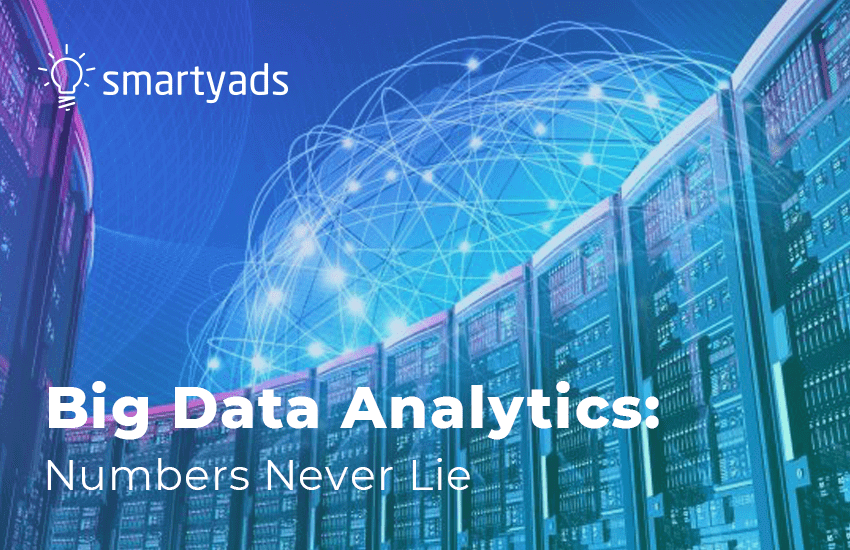In 1937, the world’s first big data project by Franklin D. Roosevelt’s administration incorporated around 29 million record entries, which, in those times, was absolutely overwhelming. No one could have foreseen that by 2016, worldwide internet traffic would surpass 1 billion terabytes.
According to the research by SINTEF, 90 percent of the world’s data has been generated in the past few years. We click, download, share information, make photos and videos, send emails, and produce instant messages. It is predicted that 1.7 megabytes of new data will be produced for every human being per second by 2020.
Big data requires big storage, and by 2020, the global investment in data storage, cloud computing, 5-D data storage and security will grow by 40 percent. We are creating and storing data at unprecedented speeds.
However, you might be surprised to hear that only 0.5 percent of the world’s data is actually analyzed, and only 5 percent of all data is considered structured. Big data analytics can tame information by extracting valuable insights from the raw matter. Let’s uncover the truth about big data analytics and discuss how data can possibly benefit your business.
What Is Big Data, and Where Does it Come From?
“Big data” was added to the Oxford Dictionary in 2013 with this definition: extremely large data sets that may be analyzed computationally to reveal patterns, trends and associations, especially relating to human behavior and interactions.
The Cambridge Dictionary defined big data as “very large sets of data that are produced by people using the internet and that can only be stored, understood and used with the help of special tools and methods. Big data cannot fit the architecture of a typical database because it is massive and dynamic. At the same time, large data processing cannot be performed by conventional database management systems because it exceeds their capacities by default.
IBM claims that big data comes from three primary sources:
- Social media data (likes, shares, tweets, comments, image and video uploads);
- Machine data (information from sensors, industrial equipment, road cameras, GPS devices, satellites, medical devices);
- Transactional data (offline and online transactions, invoices, payments, delivery receipts, storage records).
What Is Big Data Analytics?
Big Data analytics is a process of examining, filtering, aggregating and modeling large chunks of data to discover hidden patterns, marketing trends, conclusions and meaningful correlations between variables. Data mining is a data analysis technique that is used to derive patterns and sequences that are used for predictive purposes. Raw data by itself is chaotic and presents minimum value. Analytical techniques are used to retrieve intelligent insights from the data and to drive decisions in many areas of business.
Normally, data comes from various sources — digital and traditional, online and offline. Additionally, data can be stored on the separate platforms. For example, a company’s sales department and financial department may have different databases on customer profiles and sales transactions. Such isolation of the data inside the same organization may lead to a stumbling block of the data analytics, also known as a “data silo.” To solve the problem of the data silo, corporations have to invest in data integration. Data analysis is only possible when data is retrieved and combined with one data-centric architecture that can be easily accessed by other applications and where data is updated in real time.
Big data interpretation involves such advanced techniques as machine learning; big data analytical statistics; natural language processing; predictive analytics; and text, video, and audio analytics. Almost any kind of data can be processed and analyzed. Text analytics techniques include information extraction (IE), text summarization, question and answering (QA), and sentiment analysis. Social media analytics consist of content-based and structure-based techniques, community detection, social influence analysis, and link prediction.
Finally, it is possible to analyze data through multiple analytical options. For instance, descriptive analysis can help to understand the reasons of the events, explain how those reasons affected the outcomes and provide historical insights. Predictive analytics, on the other hand, are based on the present data and are capable of predicting possible outcomes, estimating possible reactions and determining the consequences. Prescriptive analytics do not only predict the future outcome but also provide possible solutions and action plans.
What Is Big Data Analytics Process?
Big data analytics mean breaking something into separate elements for a detailed examination. The process of data analysis involves multiple stages, starting from the obtaining the raw data and ending with a delivery of the desired output. The lifecycle of data analytics depends on a business case but can be broken down into major phases.
Data Specification
At this stage, it is important to specify which data is needed for the analysis and where it must come from. Determine a file naming and file storing system beforehand, and set clear requirements for the data that has to be collected. Decide which database system or information source (Facebook, emails, LinkedIn, search engines) will be used from which to acquire data. Finally, personnel within the organization must work collaboratively to avoid data duplication and missing gaps in the provided data sets.
Data Acquisition
During the second stage, data is collected. In digital marketing, data about the user is gathered: locations, status updates, image downloads, links, interactions, search history, comments, etc. The system will collect data on how much time the user spends on the page, how many clicks were generated, the topics and interests of that visitor, and other information that corresponds to objectives of the data analysis.
Data Processing
After the collection of data, the system starts to organize it by structuring into several categories. A digital statistical software might be used at this stage, or data can simply be distributed into columns, rows and tables in the spreadsheets.
Data Validation and Cleansing
This step in data analytics involves cleaning and filtering to ensure high quality of the data. The system will look for the incomplete pieces of data, errors, typos, duplications, nonsense information, inaccuracies and omissions. The failing elements will be deleted or asked to be replaced.
Data Analysis
After refining and distilling, the system will start to employ exploratory analysis of the data. The main objective of this stage is to understand characteristics of data. The exploratory analysis defines causes of the event, helps to understand the nature of data, assess assumptions and pinpoints key features in the data for further analysis.
Data Modeling
Key features generated in the previous stage are used to feed the mathematical formulas and machine learning algorithms to formulate a model. Algorithms will help to identify the cause-and-effect relationships, mutual relationships and connections among variables.
Generation of the Output
The system will generate a model that will imitate a real business problem and set a task, for example, to predict the outcome of the action. What follows next is training and testing possible solutions to predict the behavior of the variables.
Data Visualization and Presentation
Once the data is analyzed and the output is generated, it may be presented in various forms, such as tables, charts, visual plots or graphs. The output will present the results of data analysis as well as valuable insights that were not possible to obtain without machine processing.
The Seven "V"s of Big Data?
Big data analytics create both opportunities and challenges. For proper big data analysis, it is important to know the characteristics of big data that have been traditionally defined by seven Vs: volume, velocity, variety, veracity, value, variability and visualization.
- Volume: the actual amount of data or how much data weights. An average PC computer in 2000 had 10GB of storage, whereas today, typical PC users enjoy 500GB to 1TB of hard drive memory. For comparison, Google processes somewhere around 3.5 billion search requests per day and claims to store 10 to 15 exabytes of data (1 exabyte equals 1 billion terabytes).
- Velocity: the rate at which data is generated and the speed at which it must be processed. Nowadays, with torrents of data coming from sensors and devices, data has to be analyzed immediately. Machines produce multiple outputs in milliseconds, and the highest data velocity is considered nearly real-time evaluation and action.
- Variety: data types. Data is classified into structured, semi-structured and unstructured. Structured data is presented by numerical information in the tabular formats. Text, email, financial transactions, digital images, video files are examples of an unstructured data that requires structural organization.
- Veracity: trustworthiness and consistency of the data. To produce credible results, data must possess quality. If the data is incomplete, ambiguous or contain errors or duplicates, it cannot be analyzed or processed correctly.
- Value: whether data can be easily accessed to deliver quality analytics. If the data is valuable, it delivers actionable insights, enables informed decisions and provides significant details.
- Variability: constant change of data’s meaning. What a piece of data means today could mean a radically different thing tomorrow. For this reason, data has to be processed in real time because the results can be outdated the next morning or even the next second.
- Visualization: way to present. Once data is processed, it must be demonstrated in a comprehensible manner. To visualize data, you need complicated graphs with a number of variables that still have to be readable for the audience.
How to Use Big Data Analytics in Marketing
Big data is used in a myriad of industries, such as banking and securities, communications, media and environment, health care and education, manufacturing, science and research, security and law enforcement, financial trading, and others. Recently, big data has been exploited largely in digital advertising and data-driven marketing to obtain a clearer picture of the target audience and to achieve better performance in advertising campaigns.
According to the article by Forbes, 48 percent of marketers use big data for customer analytics, 21 percent for operational analysis, 12 percent for fraud and compliance, 10 percent for new product and service innovation, and 10 percent for data warehouse optimization. If such a huge number of businesses use big data analytics as a part of their business strategy, big data must present some outstanding opportunities.
Comprehensive big data analytics allows marketers to:
- Collect data about customers, understanding who they are, what they like and what they need, which ultimately leads to a 360-degree view of the consumers;
- Create highly detailed profiles of the target audiences with the necessary attributes, such as demographics, geolocation, interests, hobbies, devices, social status and others;
- Understand the patterns of online and offline consumer behavior, which allows optimizing advertising campaigns in real time;
- Identify the causes of marketing failures and find optimal solutions with predicted outcomes;
- Improve customer engagement and leverage the ability to deliver personalized, highly targeted advertising messages at the right time, place and context;
- Monitor the performance of the marketing campaign in real time and track consumer engagement levels; and
- Plan and launch high-performance advertising campaigns that bring considerable revenues.
Big data is the source of knowledge that can help businesses and brands make informative decisions at any stage of the advertising campaign. In order to turn raw data into intelligent insights, one must carefully interpret it with the help of big data analytics platforms and software. Such companies as IBM, HP, Microsoft, Dell, Teradata and Oracle provide analytics solutions for companies of any sizes.
It’s time for you to uncover the secrets of your big data!

